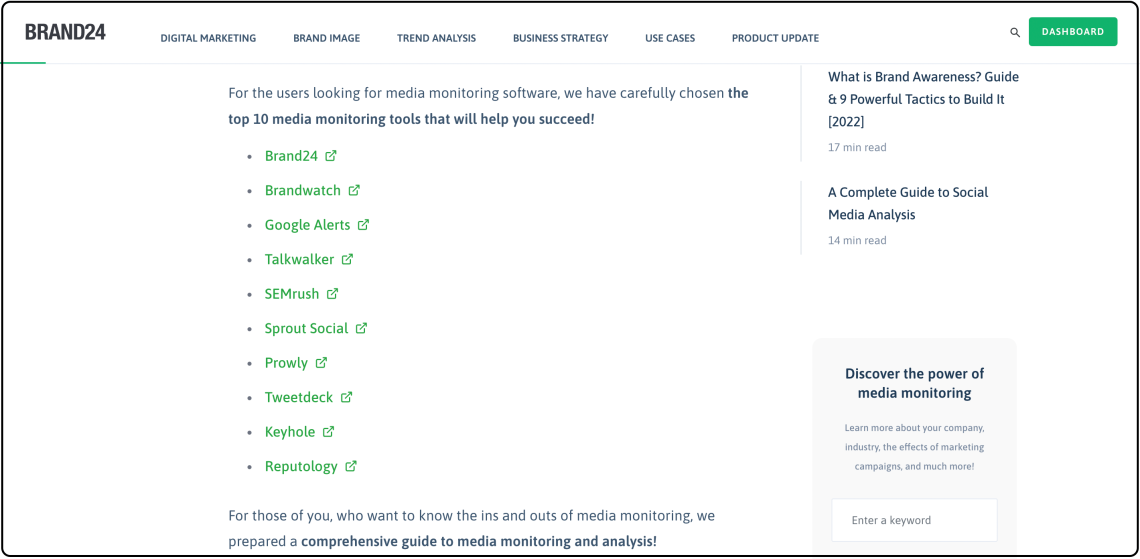How to Make a Strong Content Marketing Campaign? (with Tools and Downloadables)
Table of contents
As a company, we put a lot of marketing efforts into content creation and promotion. We work hard to deliver great content for our target audience and decided to share our success story with you. In this article, you will learn what content marketing is, how to prepare a strategy, try the best tools, and find downloadables such as a sample content plan. Dive deep into the content marketing strategy guide with Brand24.

“Content is king”. I’m sure you’ve heard this phrase thousands of times if you are not new to marketing. Is it true? Although many argue that the phrase is outdated (after all, it was coined by Bill Gates in 1996), it’s hard to imagine any marketing campaign without content.
In recent years people look less for content marketing definitions, but companies still need this channel to have a full array of advertising resources and tools.
Today we will discuss the definition of content marketing, how it connects with SEO efforts, look at some examples, and plan your own strategy.
Table of contents:
- What is content marketing?
- Inbound marketing vs content marketing
- B2B content marketing
- Content marketing trends
- SEO in successful content marketing strategy
- Content marketing examples
- Content marketing tools
- Content marketing plan [download]
- When to start content marketing strategy?
What is content marketing?
Before we begin planning the strategy, we need to define content marketing. Feel free to skip to the next chapter if you are here for more specific information.
Content marketing includes all types of content you can use for advertising. This usually means written text – in most companies content marketing specialist is usually a copywriter. But there’s also image and video content marketing.
Basically, everything that’s on your website; every marketing asset can be included in your content strategy.
To answer the question – content marketing is a marketing strategy used to attract and engage your audience through visual assets, such as articles, videos, infographics, podcasts, etc.
Monitor online mentions about your brand or selected keywords with Brand24.
Inbound marketing vs content marketing
“Inbound marketing” is sometimes used as a synonym for content marketing. While both strategies rely on creating valuable content, there are a few differences.
Inbound marketing strategy encourages users to perform certain actions on your website through content. Content marketing, on the other hand, focuses on the precise techniques for producing and distributing content through various platforms.
These marketing tactics are similar, but not the same. This is something to keep in mind.
B2B content marketing
In recent years, there’s been a huge spike of interest in B2B content marketing. As Semrush reports, content marketing is a strong tactic when selling to other businesses. This shouldn’t be surprising – a lot of pages ranking high in SERPs (Search Engine Result Pages) are B2B companies.
If you’d like to dive deeper, here’s a guide to the most important B2B marketing metrics you should track, as well as insights on how B2B social listening can elevate your strategy.
Content marketing is useful both in B2C and B2B sales and it doesn’t matter which profile is your company – investing in content strategy will almost always pay off.
Content marketing trends
The term “content marketing” was coined in 1996 by a man called John F. Oppedahl during a roundtable discussion at the conference of the American Society for Newspaper Editors.
Since then we’ve seen different variables of strategic marketing approach focused on content creation.
Today, content marketers are mostly seen as copywriters – people who manage blogs and landing pages, work with SEO, and occasionally cooperate with graphic designers on visual content.
Not that long time ago, Google bots weren’t so clever and you could just use keyword stuffing to promote your landing pages in SERPs. Now, it’s not that simple.
The main trend we can observe is a turn from writing for search engines to writing for humans. Stuffing keywords is no longer needed – in fact, these tactics can even end in Google penalties. The best content marketing examples are pieces of writing that are insightful, precise, and fully answer the question.
Here’s a list of the most visible content marketing trends in 2022:
- Empathetic writing. Write your content for the specific target audience, do not focus on Google Bots or other search engines. If your piece of content is good, it doesn’t need keyword stuffing. The only thing that will help bots to understand your subject is the correct use of H1/H2 headlines, the meta title, and the URL.
- Content repurposing. Content marketing is not only writing – you can easily repurpose your articles. Video content marketing is booming, and you can still jump on the YouTube or TikTok bandwagon. Use your written content to produce videos, podcasts and infographics, and share them through channels other than your blog.
- Video content marketing. Again, thanks to the rise of TikTok, video content is very popular again. You don’t need to be super creative – you can use your existing content and convert it to a short video format.
- User-generated content. People today need social proof to trust a brand, and there’s no better way to introduce yourself than through user-generated content. Engage in influencer marketing, ask your customers to share UGC, and create contests for current and potential customers. Sharing such content via social media platforms helps in building brand awareness a lot.
- Social responsibility. The times of wild capitalism have come to an end. Brands need to take more responsibility for their actions. Show that in your content marketing strategy. Eco and environment-friendly brands are moving ahead of those who don’t care about our planet. Consumers are much more aware nowadays.
Follow social media trends by monitoring keywords from your niche with Brand24. Free trial available!
SEO in successful content marketing strategy
Search engine optimization plays a huge role in content marketing. If you are writing blog posts, they need to be optimized for SERPs. What’s the point of creating evergreen content that is supposed to drive traffic to your site if it’s not ranking on the first page of Google?
Of course, every now and then, you will write a blog post that doesn’t need SEO – feature updates, announcements, etc. They are not really a part of content marketing strategy – they are more product-related.
There’s a good chance you already have some content on your website. It’s good to check the state of SEO of your landing pages and blog posts. We have prepared a quick guide if it’s better to create new content or optimize existing ones.
Content marketing is too close to SEO to overlook it. If your content is to perform well in search, you a proper SEO strategy is a must. You don’t have to worry about SEO if the content is created for paid ads.
Content marketing examples
Let’s put the theory aside for now, and see some real-life content marketing examples from brands that are great at digital marketing, and consistently push out lots of valuable content.
“Shot on iPhone” by Apple
While Apple is not really present on social media, they are active on Instagram. Their content marketing campaign includes the hashtag #ShotOniPhone and encourages people to make user-generated content with their phones. The best photos are shown on the official Apple Instagram page and during release events.
Why it’s a good campaign? It shows off the possibilities of iPhones and encourages existing users to create user-generated content that works as social proof. Any photographer looking for a great camera phone will stumble upon Apple’s Instagram and see the amazing pictures you can take with an iPhone.
Evergreen content by Brand24
Yes, we rely a lot on content marketing ourselves. One of our tactics is to create lists of the best digital marketing tools to help editors create content. These types of articles perform great in Google and bring valuable traffic. And because the main goal of such lists is conversion, they always feature a solution from Brand24.

Why it’s a good campaign? All our blog posts are search engine optimized with the intent in mind. We prepare articles for people seeking recommended tools for specific actions and give them a lot of choices.
Slowhop articles with topical lists of places
Slowhop is a Polish travel website that works similar to Airbnb or Booking, except it only collects very stylish and unique places to rent, and promotes the slow life experience. Because the site is also offered in English, it’s easier to use for all foreigners living in Poland.
One of their blog articles is about places that can be reached with a train – super useful for travellers seeking quiet spaces, but don’t have a car.
Why it’s a good campaign? Unique places such as those featured on Slowhop are usually hidden in less popular areas and small towns that can be reached only via car. To be more inclusive, Slowhop presents a list of places that can be reached with a train or bus, thus broadening the number of potential customers.
Content marketing tools
Fortunately for us content marketers, there are a lot of tools that can help with the job. There’s so much more than just Google Docs or Microsoft Word. Here are some tools that I know and use, and can happily recommend.
SurferSEO
SurferSEO makes writing blog posts much easier. It’s a powerful tool for content marketers that allows you to come up with new article ideas, audit existing ones, and (the most important part of SurferSEO) write new texts with keywords.
SurferSEO’s Content Editor analyzes the top-ranking pages and suggests how long your piece of content should be and which similar phrases and words you should use. The tool will give you a score (0-100) based on how good your article is. The higher the score, the more chances you have to rank as #1.
After you publish your article, you can run an audit to see how it compares to your competitors. The tool will also suggest backlinking opportunities and help you add some internal links.
(In fact, I am using SurferSEO to write this very article.)
Brand24
Brand24 is a media monitoring tool that’s great for running PR campaigns, measuring brand awareness, auditing social media presence, and much more.
Brand24 is a content marketing tool that gets you up to date with the latest trends, but first and foremost is great for gathering user-generated content.
Once you set up a project, you can start monitoring your brand, and gathering mentions about your products. You can then use the mentions and reviews in your videos, articles, social media posts, newsletters, and landing pages. Of course, don’t forget to ask the original posters for permission if you want to use their content in your marketing campaigns.
Start monitoring your brand’s presence with our social listening tool.
Ahrefs
Ahrefs is a tool many SEOs use and recommend. In content marketing, it’s useful for keyword research and rank tracking.
It’s hard to imagine creating written content without thorough keyword research, which is not easy without the right tool. Of course, there are some free solutions, but we all know that paid tools offer much more value.
Ahrefs is one of the top content marketing tools.
Headline Studio by Coschedule
If you do a lot of SEO, you know how important a good headline is. Coschedule prepared a nifty tool that analyzes your headlines and offers actionable suggestions to improve them.
After you enter your headline, Headline Studio will grade your work and suggest which parts need changing. In addition, the paid version includes a thesaurus and dictionary that will help you choose your words for a strategic marketing approach.
Canva
It’s great to have a graphic designer at hand, but not everyone can afford this luxury. If you lack graphic skills and don’t have access to professional tools like Adobe Photoshop or Illustrator, there are cheaper alternatives like Canva.
Canva offers both free and paid templates, ready designs, and illustrations. If you are in need of an infographic or blog post header photo – try the tool. You can create content from scratch or use pre-made templates. It may never replace your in-house designer, but something is better than nothing, and with Canva you can create really useful designs.
Jasper (FKA Jarvis)
Formerly known as Jarvis, Jasper is an AI writing tool. It can generate short texts and long articles on demand. Just enter your topic and the tool will automatically come up with a piece of content for you.
The texts, however, are NOT of the top quality, so always perform a double check – and don’t expect the content to outperform carefully optimized articles from the Google top 10 results. It’s handy when you have to quickly come up with shorter and less significant pieces, though.
If you are facing writer’s block, Jarvis will help you overcome it.
Asana
Asana is a project management tool that is perfect for creating content calendars.
Within your Asana project, you can create tasks and subtasks corresponding to your content efforts. It’s especially useful when you are working with other people – you can add them to your projects and delegate tasks, such as making graphics, keyword optimization, etc.
Grammarly
No matter how good your written language is, it’s always good to perform proofreading. The ideal scenario is you have a native speaker with a degree in philology or similar. But we all know that’s not always the case – sometimes there’s just no time to get your piece of content checked.
Here comes Grammarly – an app that will do the proofreading for you. The tool will not only correct your spelling errors but also evaluate your language’s quality. You can set it to check your text as an academic report or just an informal note. Grammarly will fix your mistakes to match the desired outcome.
Rank Math
If you are using WordPress to publish content, you should invest in an SEO plugin to help you organize meta descriptions and titles.
Rank Math is one of the plugins you can use. Its advanced options will let you easily manage on-site SEO by helping you use the right meta descriptions and consistent titles for your blog posts.
And what are your favorite content marketing tools? Don’t underestimate the seemingly obvious thesaurus and dictionary.
Content marketing plan [download below]
You can plan your content marketing strategy in your head, but it’s a better idea to have it written. Here are a few tips if you don’t know where to start.
Mind you, this plan applies to written content only (blog posts or landing pages, for example).
- First of all, you need to start with keyword research. There’s no magic list of keywords to begin from, it all depends on your niche and target audience. Think of what your company does, and prepare a group of phrases around that topic.
- Use a tool like Semrush or Ahrefs to check similar and related keywords. You can also use Google suggestions for that or other free tools like Keywords Everywhere (a Chrome add-on).
- Define the keyword difficulty and volume. If you are a new brand and your website has a low authority score, it’s better to try and rank for long-tail keywords instead of broad topics with high difficulty ratings and saturated SERPs.
- Check the intent of each keyword and prepare a scope for the article.
- Next, you can decide which tasks can possibly be delegated. You will probably need some pictures or illustrations for the article – that’s a job for the graphic designer. Maybe you want to include research or poll results? Either delegate these tasks or make a list of things to do before the article gets published.
- The last column on your content marketing plan should be the publishing date. Don’t worry, you don’t have to strictly stick to the dates, but try to estimate when the piece of content will be ready.
Here’s my suggestion of how a content calendar can look like. Feel free to make a copy and alter it to your needs.
Download the content calendar (copy to your Google Drive)
When to start content marketing strategy?
Now that you gathered all the important information about content marketing, the question is – when do I start? Well, the answer is simple – the sooner the better.
Bear in mind that a successful content marketing program is not achieved overnight and it may take months before you see the effects. Search engines need time to index your new blog post and visual content needs a clearly defined audience to become viral.
Take your time. Plan your next content marketing campaign carefully. Do thorough keyword research. Create amazing visual content. And don’t forget to define your target audience.
Your content marketing strategy should complement other marketing efforts your brand is pursuing.
Be consistent and don’t give up. Your content marketing efforts will succeed if you stay on track.
Good luck!
Related articles
Top Reads
Brand Monitoring: Tools & Guide for 2026
Brand Awareness Strategy [The Ultimate Guide for 2026]
The Best AI Hashtag Tracker and Other Hashtag Tracking Tools [2026]
Social Media Reach: How to Measure & Improve It in 2026?
X (Twitter) Analytics Tools: The 10 Best to Try in 2026
Sentiment Analysis: What is it & Why do You Need it in 2026?
Share of Voice: Definition, Calculation, Tools [2026 Guide]
Brand Reputation Management: 6 Expert Tips for 2026
A Complete Guide to AI Social Media Analysis [2025]
How to See How Many Times a Hashtag Was Used on X (Twitter)
Start Social Listening!
Get the Brand24 trial and start social listening like a PRO.


